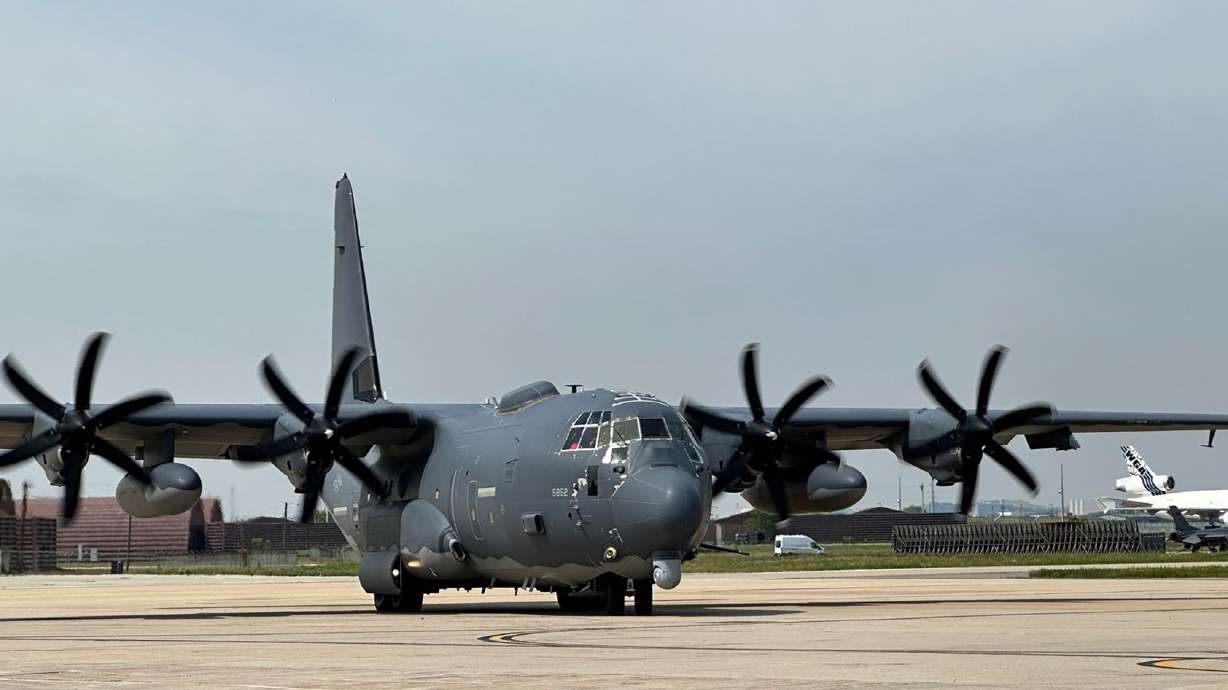Estimated read time: 5-6 minutes
This archived news story is available only for your personal, non-commercial use. Information in the story may be outdated or superseded by additional information. Reading or replaying the story in its archived form does not constitute a republication of the story.
OSAN AIR BASE, South Korea — As the U.S. Air Force AC-130J flies over South Korea's towering apartment blocks, its powerful cameras can almost see inside windows on the highest floors.
Aiming farther afield, the weapons officers on the four-engine aircraft, nicknamed Ghostrider, can pick out objects at 50,000 feet, almost 10 miles away – all potential targets for the biggest gun ever mounted on a fixed-wing plane.
CNN got an exclusive look inside the aircraft, assigned to Air Force Special Operations Command, in early June after it flew from its home base in Hurlburt Field, Florida, for joint drills in South Korea.
In a live-fire exercise, the 105 mm howitzer pumped out 43-pound shells, into a firing range east of Seoul, the force of each blast so powerful that it pushed the tail of the 80-ton plane six feet to the right.
About eight seconds after firing, the shells hit the range 10,000 feet below, sending smoke billowing skyward as the controllers of the big gun watched the results of their handiwork on large video screens in the middle of the aircraft.
"Assess two tanks destroyed," a scratchy voice confirms in the radio headsets of the AC-130 crew.
Pilot Capt. John Ikenberry said the AC-130's presence for drills in South Korea was designed to send a simple message to its belligerent neighbor North Korea and its leader Kim Jong Un.
"It shows we are ready," Ikenberry said.
Tensions have been simmering on the peninsula in recent months.
The North has been sending balloons filled with trash to areas in and near Seoul and testing missiles, and South Korean troops have fired warning shots as North Korean soldiers from the North have crossed the military demarcation line in the middle of the demilitarized zone.

Just this week, North Korea criticized live-fire exercises in the South in late June and early July as an "'inexcusable and explicit provocation."
Meanwhile, Washington has kept a steady stream of hardware heading to the South for land, air and sea exercises leading up to one of their biggest yearly exercises, Ulchi Freedom Shield, set to begin later this summer.
Experience they can't get stateside
The AC-130J, the newest version of the U.S. Air Force Hercules gunships, is testing its mettle in South Korea for the second year in a row.
Maj. Heath Curtis, combat systems officer on the Hercules, says it's important for the gunship to make the flight across the Pacific because it offers experience training where a conflict could be fought with conditions that can't be duplicated on firing ranges in Florida or New Mexico that the gunship would use in the United States.
The mountain ranges and ridges of the Korean Peninsula present wind conditions not found elsewhere, he says, and that can make a difference even to a projectile traveling more than 800 mph.
It also gives the chance for Curtis and a second officer seated at AC-130's weapons control center the chance to practice alongside South Korean allies they may need to protect in the event of a ground war on the peninsula.

The huge television monitors bring the battlefield below up close in both regular and infrared definition. The cameras mounted outside the plane can zoom in on details to ensure weapons fire is accurate.
"The unique thing about the AC-130 is the amount of fire that we bring, the amount of munitions — the diverse amount of them — and the amount of loiter time we can provide," says the mission commander for this gunship, Maj. Josh Burris.
Besides the 105 mm howitzer, the AC-130J carries a 30 mm cannon and can launch precision-guided missiles and bombs from pylons on its wings.
With the weapons' near-pinpoint accuracy, it can fire on enemy positions within shouting distance of friendly troops, earning the aircraft the title of "the infantryman's best friend" in some circles.
And with air-to-air refueling, it can, in theory, stay on station supporting ground forces as long as the crew and ammunition can last.
'Spooky' history
U.S. Air Force gunships trace their lineage back to the Vietnam War, when the service set up 7.62 mm guns to fire out one side of a C-47 transport aircraft.
With the AC-130J model, introduced in 2017, the Air Force removed the machine guns in favor of the more precision-guided munitions.
Despite the formidable firepower it carries, the AC-130 flies low and slow, making it vulnerable to anti-aircraft fire.
The AC-130's crew acknowledges the dangers of ground fire to their aircraft, and some analysts question its usefulness in any potential conflict with North Korea.
"They couldn't be operated within say 100 nautical miles of the border as they're too vulnerable to North Korean border air defenses," says Peter Layton, a visiting fellow at the Griffith Asia Institute in Australia and former Royal Australian Air Force officer.

But Layton says the gunships could be helpful supporting allied troops who might be trying to round up North Korean special forces units that had managed to infiltrate deeper into southern territory.
Still, he cautioned, "if a war starts there, try not to be on an AC-130 unless it's heading out of theater."
Maj. Christopher Mesnard, Special Operations Command Korea public affairs director, said the AC-130J is a suitable weapon system for the Korean Peninsula.
"We have the utmost confidence in our ability to operate weapons systems like the AC-130J in times and places of our choosing and in a way that adequately considers risks, regardless of the region," he said.
Contributing: Yoonjung Seo and Gawon Bae









